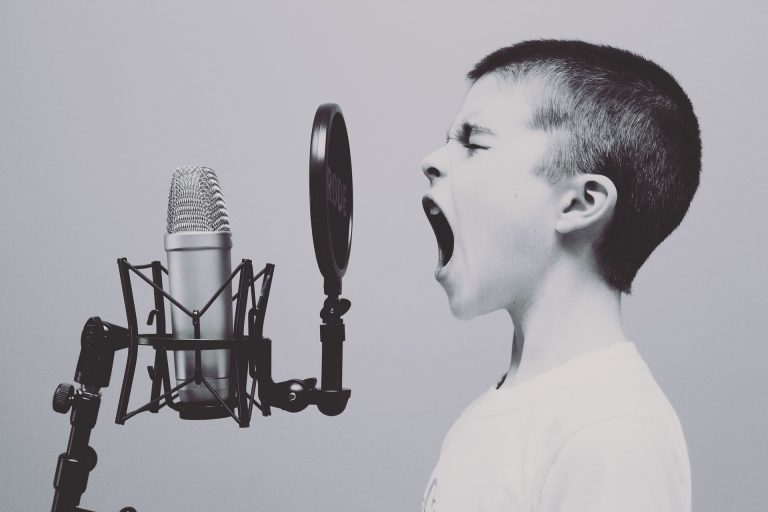The basic anatomy of singing

What is singing?
Singing is the act of using rhythm, various vocal techniques and sustained tonality to produce musical sounds. These may include humming or applying melody to words.
Basic singing mechanics
Singing as well as speaking, involve a voice mechanism that is composed of the following:
- Breath (inhale and exhale)
- Vocal folds (also known as vocal cords)
- Articulators (the parts of the vocal tract above the larynx, including palate, tongue, cheeks, teeth, lips)
- Resonators (chest, throat, oral and nasal cavities, the sinuses)

Breath is the most basic and fundamental component of all good singing, because it affects pitch, volume, phrasing, vibrato. The organs involved in breath control are the diaphragm, intercostal muscles, lungs, and abdominal muscles. These organs regulate air pressure sent through the vocal folds and thus have a significant effect on the sound we produce.
Vocal folds (vocal cords) are composed of twin infoldings of mucous membrane stretched horizontally across the larynx. When a stream of air flows through them, they vibrate in a pulsating motion that creates the laryngeal sound. The muscles of the larynx (voice box) take part in adjusting the tension and length of the vocal folds to produce a required pitch and tone.
Articulators (palate, tongue, cheeks, teeth, lips) shape vocal resonances to form distinguishable vowel sounds. They help to produce recognizable words.
Resonators (chest, throat, oral and nasal cavities, and sinuses) help to amplify and modify the sound. They also produce a person’s recognisable voice.
How is the voice produced?
- Air pressure moves towards the vocal folds by coordinated action of the diaphragm, abdominal muscles, chest muscles, and rib cage.
- To vibrate effectively and produce sound vocal folds need to be at midline or ‘closed’.
- Column of air pressure opens the bottom part of vocal folds
- Air continues to move upwards and towards the top of vocal folds
- The low pressure created behind the fast-moving air column causes the bottom to close, followed by the top.
- Closure of the vocal folds cuts off the air column and releases a pulse of air and then a new cycle repeats.
- The rapid pulses of air created by repeat vibratory cycles produce ‘voiced sound’.
- The produced sound is buzzy, and it is then amplified and modified by the vocal tract resonators to create our distinctive speaking and singing voice.
The many shades of the voice
Our voices can take on a wide spectrum of qualities and colours. We can speak, whisper or shout and we are able to modify the way we sound in a number of ways. The nose, throat and mouth amplify and modify the sound. This in turn enables us to produce a vast array of tonal qualities and different singing styles, e.g. opera, pop, rock, gospel, jazz, blues, etc.
The sound of each individual’s singing voice is unique and influenced by a combination of the following factors:
- the shape and size of the vocal cords
- the shape and size of the rest of the body, including the chest and neck, the position of the tongue, and the workings of the muscles (tension and tightness)
- the size and bone structure
- the position of the larynx
All of the above take part in shaping the pitch, volume, timbre and tone.
Vocal technique
Good singing technique doesn’t require much muscle strength, but it does require a well-balanced coordination of all processes involved in producing vocal sound, i.e.
- respiration (breath is taken)
- phonation (sound is initiated in the larynx)
- resonation (resonators receive the sound and modify it)
- articulation (articulators shape the sound into recognisable singing voice)
Difficulties to coordinate these elements effectively, will have an impact on the student’s ability to:
- extend the vocal range
- develop consistent vocal production and tonal quality
- develop flexibility and agility
- achieve a balanced vibrato
Developing the singing voice
Singing is a blend of vocal technique and interpretation and the best results in vocal skill development can be achieved when the following areas are adequately catered for:
- vocal health – singers should take good care of their voices and bodies through eating well balanced and nutritious diets, staying hydrated, ensuring sufficient rest, and staying fit, as general fitness will improve muscle coordination, breath control, and stamina.
- safe technique – effective vocal development requires regular practice. However, singers should never feel any discomfort during singing, so any exercises that cause even the slightest form of pain, should be abandoned straight away. Pain when singing indicates poor and unhealthy technique.
- warm up exercises – vocal warm-ups play a crucial role in the development of a healthy singing voice. It is good practice to gently warm up the vocal instrument in preparation of singing. Whilst vocal warm-ups don’t need to take too much time, a warm-up routine is highly recommended to help the voice get ready for greater demands.
Singing is not only a wonderful form of expression, but it is also an activity that has vastly positive effects on people’s health. It can help to develop greater lung capacity, improve mood, and reduce stress. It has a positive influence on the immune system, provides many cognitive and emotional benefits and it is becoming a popular method of helping individuals improve their general health and wellness.
Happy singing!
Sources: Wikipedia, Voice Foundation
